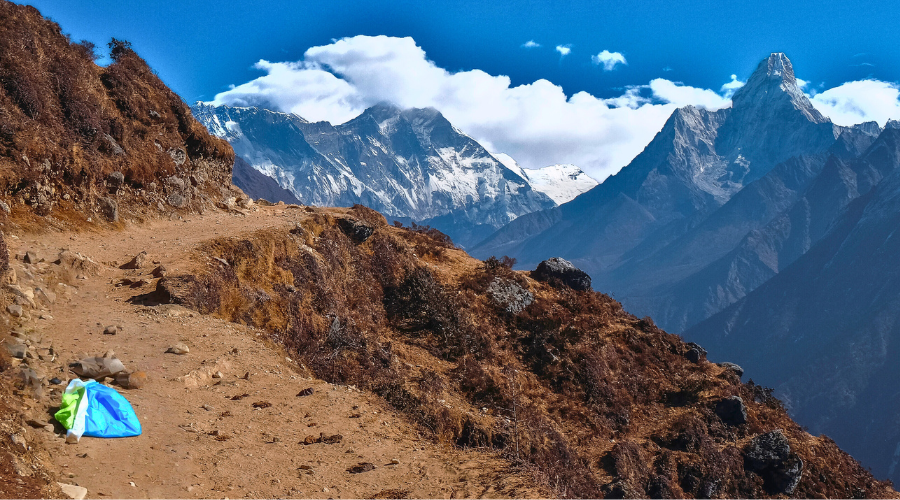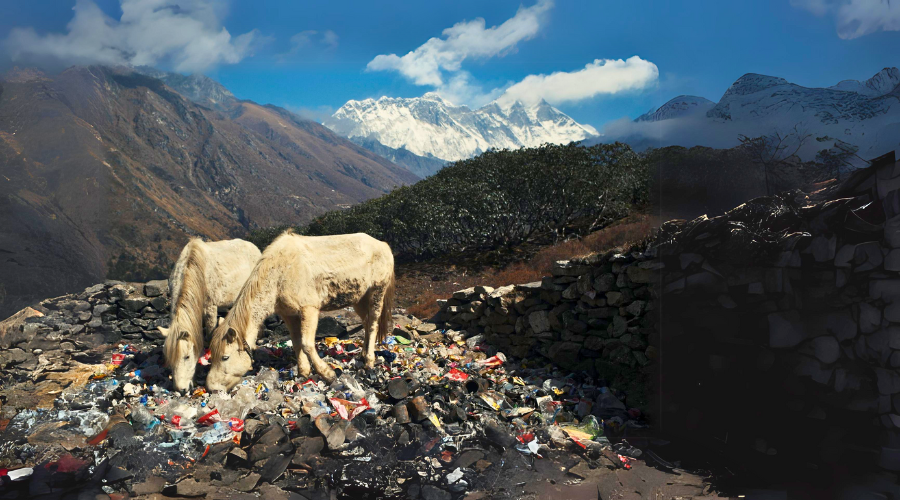
Trash on the Trail: The Everest Base Camp Trail's Untold Story

Trash on the Trail: The Everest Base Camp Trail's Untold Story
swotah travel
1044
11, 04 2024
Mount Everest, the world's highest peak, beckons thousands of climbers and adventure enthusiasts to its slopes each year. The journey to Everest Base Camp (EBC) is not just a trek; it's a pilgrimage to the heart of the Himalayas. However, beneath the breathtaking vistas and monumental achievements lies an untold story: the issue of litter along the Everest Base Camp trail. This narrative delves into the depths of this growing problem, the efforts to combat it, and the call to action for every trekker.

Photo Credit: martinedstrom.com
The Magnitude of the Problem
The EBC trail, stretching approximately 130 kilometres round trip from Lukla, is not just a path but a conduit for dreams, aspirations, and, unfortunately, a significant amount of waste. Each year, the influx of trekkers, which numbers in the tens of thousands, leaves behind a trail not just of footprints but of plastic bottles, food wrappers, equipment, and more. It's estimated that over 8,000 kilograms of waste are generated annually by trekking activities alone, contributing to an environmental crisis that threatens the very beauty and sanctity of the Himalayas.
The issue is not just cosmetic. The environmental impact is profound, affecting local wildlife, water sources, and the health of the local Sherpa communities. The waste, much of which is non-biodegradable, poses a significant challenge in a region where waste management infrastructure is minimal, and the harsh conditions make decomposition a slow process.
Efforts to Combat the Problem
Addressing the waste issue is a monumental task, compounded by the region's challenging geography. The remote and rugged terrain of the Khumbu Valley makes establishing and maintaining effective waste management systems a daunting endeavour. Additionally, the seasonal nature of trekking and climbing activities leads to a concentrated period of heavy foot traffic, overwhelming the limited waste disposal facilities and straining local communities responsible for trail maintenance.
Recognizing the urgency of the situation, various stakeholders have mobilized to confront the challenge head-on. Clean-up campaigns initiated by conservation groups, non-profit organizations, and local authorities have made significant strides in removing litter from the trails. These efforts not only involve the physical collection of trash but also aim to instil a sense of environmental stewardship among trekkers and the local population. Meanwhile, some trekking companies have set a positive example by adopting eco-friendly practices, such as encouraging the use of refillable water bottles and ensuring that all waste is packed out.
Since 2020, the Khumbu Pasang Lhamu rural municipality has banned all plastics less than 30 microns thick, including drinks in plastic bottles. However, the ban has not been effective.
The Everest Base Camp trail is dotted with approximately 100 waste bins, courtesy of the Sagarmatha Pollution Control Committee (SPCC), an independent organization dedicated to maintaining the cleanliness of the Khumbu area. These bins are strategically placed at natural resting spots to motivate hikers to sort their refuse—separating cans, tins, and bottles from other types of trash (distinguishing between combustible and non-combustible materials). Since its inception in 1991, the SPCC has committed to enhancing local engagement in waste management, establishing a robust waste separation system, and exploring avenues to minimize waste generation. Emphasizing the importance of repurposing and recycling, the SPCC upholds the principle that “waste is not waste until it’s wasted,” a philosophy now embraced by various groups within the region.
Addressing this issue goes beyond the responsibility of local authorities alone; it falls significantly on the travellers themselves to maintain the cleanliness of the trail. Therefore, travellers should adopt the following principles to contribute effectively.
1. Practice Leave No Trace Principles
Adopting Leave No Trace principles is fundamental. This means packing out all the waste you create, including food wrappers, bottles, and other trash. Be mindful of your impact on the natural surroundings and ensure that you leave the areas you visit exactly as you found them or even better.
2. Use Reusable Water Bottles and Containers
One significant source of litter on the trails is single-use plastic bottles and containers. By carrying a reusable water bottle and purifying your water using tablets or a filter, you not only reduce your waste but also minimize your carbon footprint. Similarly, using reusable food containers and utensils for your meals can significantly cut down on garbage.
3. Participate in Clean-Up Initiatives
Joining clean-up campaigns along the trek can amplify your positive impact. Many organizations and groups organize clean-up treks or dedicate a day of their journey to collecting litter found along the trails. Participating in these initiatives helps not only clean up the path but also raise awareness among fellow trekkers.
4. Choose Eco-Friendly Tour Operators
Select tour operators who are committed to sustainable practices and environmental stewardship. Some operators actively engage in eco-friendly initiatives, enforce strict waste management protocols among their teams, and contribute to conservation efforts in the Everest region. By choosing these operators, you support practices that help in preserving the natural beauty of the Himalayas.
5. Educate Yourself and Others
Awareness is key to change. Educate yourself about the environmental challenges facing the Everest region and share this knowledge with fellow trekkers. Encourage your peers to adopt eco-friendly practices and discuss the importance of maintaining the cleanliness of the trails. A collective effort can lead to a significant reduction in the litter problem.
6. Carry a Trash Bag
Having a small trash bag with you during your trek allows you to easily carry back your waste. It also empowers you to pick up any litter you might find along the trail. While it may seem like a small gesture, if every trekker adopted this practice, the cumulative impact would be profound.
7. Support Local Conservation Efforts
Many local organizations work tirelessly to address environmental challenges in the Everest region. Supporting these organizations, whether through volunteering, donations, or simply by adhering to their guidelines, can greatly enhance the effectiveness of conservation efforts.
8. Advocate for Sustainable Practices
Use your voice to advocate for sustainable practices within your trekking group and beyond. Share your experiences and the importance of conservation on social media, blogs, or with your community. Advocacy raises awareness and can inspire others to take action.
Swotah for a Sustainable EBC Trek
Choosing the right trekking company is crucial when planning your journey to Everest Base Camp (EBC), especially if you're committed to minimizing your environmental footprint. Swotah Travel stands out as a beacon of sustainable trekking practices, offering an EBC trek that not only promises an unforgettable adventure but also ensures that your journey contributes positively to the preservation of the Everest region. Here are compelling reasons why Swotah Travel is your go-to partner for a sustainable EBC trek.
Commitment to Sustainability
Swotah Travel embeds sustainability at the core of its operations. We understand the delicate balance of the Himalayan ecosystem and the impact trekking can have on this fragile environment. Our commitment is reflected in their strict adherence to eco-friendly practices, such as minimizing waste, using renewable energy sources whenever possible, and ensuring that their activities do not disturb the local wildlife or damage the natural landscape.
Eco-Friendly Practices on the Trail
Swotah Travel encourages trekkers to use refillable water bottles and provides water purification solutions to reduce dependence on single-use plastics. We also prioritize the use of biodegradable and reusable materials for all trekking provisions. This commitment to reducing waste is a vital component of their sustainable trekking policy, ensuring that the trails remain clean and untouched.
Supporting Local Communities
Understanding that sustainable trekking goes beyond environmental conservation, Swotah Travel actively supports the local communities in the Everest region. By employing local guides and porters, purchasing local supplies, and engaging in community development projects, we ensure that the benefits of tourism are shared with those who call the Himalayas their home. This approach fosters a positive relationship between trekkers and local communities, promoting cultural exchange and mutual respect.
Participation in Conservation Initiatives
Swotah Travel not only practices sustainability but also contributes to conservation efforts in the Everest region. We participate in and sponsor clean-up campaigns to remove litter from the trails and base camp areas. Moreover, a portion of their profits is donated to environmental organizations working on the ground to preserve the natural beauty of the Himalayas. By choosing Swotah Travel, you directly support these vital conservation initiatives.
Education and Awareness
Swotah Travel believes in the power of education and awareness. We prepare their trekkers for the journey with comprehensive briefings on the importance of sustainable trekking practices. Throughout the trek, guides share insights into the local ecosystem, its challenges, and the ways in which every trekker can contribute to its preservation. This educational aspect enriches the trekking experience, leaving trekkers with a deeper understanding and appreciation of the natural world.
Tailored Sustainable Itineraries
Recognizing that one size does not fit all, Swotah Travel offers tailored itineraries that can be adjusted to match your sustainability goals. Whether it’s incorporating additional days to explore off-the-beaten-path trails or arranging visits to local conservation projects, we are flexible and accommodating. This personalized approach ensures that your trek is not only memorable but also aligns with your values.
Also, Read Realities of low-cost trekking Packages in Nepal
NEWSLETTER SIGNUP
Sign up to receive our trip ideas and travel offers!
Get updates and Exclusive Offers up to 20% Discount








